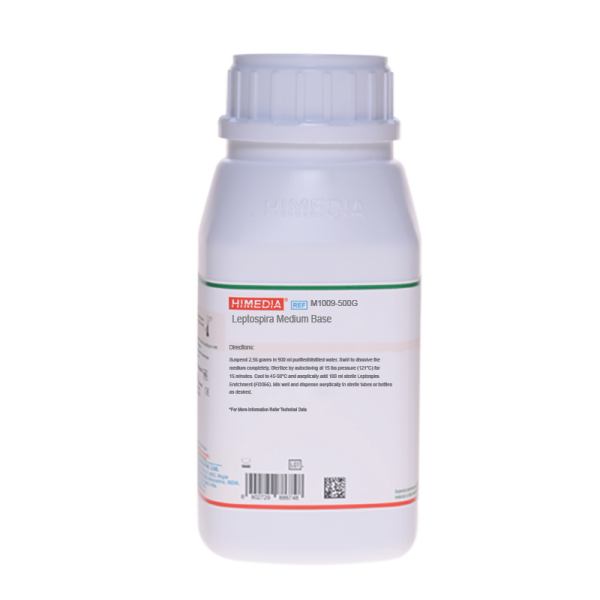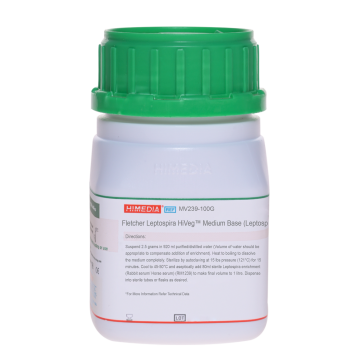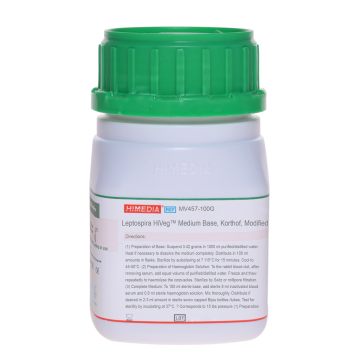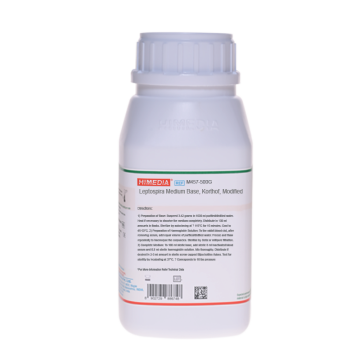 Your enquiry has been submitted
Your enquiry has been submitted
Leptospira Medium Base
Intended Use
Recommended for cultivation and maintenance of Leptospira species.
Composition
| Ingredients | g/L |
|---|---|
| Disodium hydrogen phosphate | 1.000 |
| Potassium dihydrogen phosphate | 0.300 |
| Sodium chloride | 1.000 |
| Ammonium chloride | 0.250 |
| Thiamine | 0.005 |
Final pH (at 25°C): 7.5±0.2
Formula adjusted, standardized to suit performance parameters
Directions
Suspend 2.56 grams in 900 ml purified/distilled water. Swirl to dissolve the medium completely. Sterilize by autoclaving at 15 lbs pressure (121°C) for 15 minutes. Cool to 45-50°C and aseptically add 100 ml sterile MV Enrichment Supplement (FD066). Mix well and dispense aseptically in sterile tubes or bottles as desired.
Principle And Interpretation
Leptospirosis is an acute febrile disease caused by members of the genus Leptospira (1,2). Direct culture of blood is the most reliable way to detect Leptospira during the first week of illness. After the first week of illness and for several months thereafter, leptospires may be isolated by direct culture of undiluted urine specimens. By autopsy, leptospires may be isolated from kidney and liver tissues as well as from blood and urine. The Leptospira Medium Base was originally formulated by Ellinghousen and McCullough (3) and modified by Johnson and Harris (4). Leptospira Medium Base is enriched by the addition of Leptospira Enrichment.
Leptospira Enrichment supplement provides long chain fatty acids as the carbon, energy source and vitamin for the growth of Leptospira. The salts supply essential nutrients for the growth of the organisms. Phosphates form buffering system while sodium chloride maintains osmotic equilibrium and also provides essential ions. Leptospira metabolizes the fatty acids by beta-oxidation and the metabolic end products formed are acetate and carbon dioxide.
All cultures are incubated at room temperature in the dark for up to 6 weeks. The organisms grow below the surface. Material collected from a few centimeters below the surface of broth cultures should be examined weekly for the presence of growth using a direct wet preparation under dark field illumination. Letpospires will exhibit corkscrew like motility (1). Examine the tubes for growth every 5-7 days. Growth occurs as a ringed area (disc) 1-3 cm below the surface of the medium. The absence of a ringed area of growth doesn't necessarily mean leptospires are not present. Remove a small amount of growth from the disc area and examine microscopically (gram stain is not satisfactory). Microcolonies can be fixed with methanol and stained with Giemsas stain to show rod forms (5).
Type of specimen
Clinical samples - urine; Water samples
Specimen Collection and Handling
For water samples, follow appropriate techniques for sample collection, processing as per guidelines and local standards (6). For clinical samples follow appropriate techniques for handling specimens as per established guidelines (7,8). After use, contaminated materials must be sterilized by autoclaving before discarding.
Warning and Precautions
In Vitro diagnostic Use. For professional use only. Read the label before opening the container. Wear protective gloves/ protective clothing/eye protection/face protection. Follow good microbiological lab practices while handling specimens and culture. Standard precautions as per established guidelines should be followed while handling clinical specimens. Safety guidelines may be referred in individual safety data sheets.
Limitations
- Individual organisms differ in their growth requirement and may show variable growth patterns on the medium.
- Each lot of the medium has been tested for the organisms specified on the COA. It is recommended to users to validate the medium for any specific microorganism other than mentioned in the COA based on the user's unique requirement.
Performance and Evaluation
Performance of the medium is expected when used as per the direction on the label within the expiry period when stored at recommended temperature.
Quality Control :
Appearance White to cream homogeneous free flowing powder
Colour and Clarity of prepared medium Basal medium: Colourless clear solution; After addition of FD066: Light yellow coloured clear solution in tubes
Reaction Reaction of 0.256% w/v aqueous solution at 25°C. pH: 7.5±0.2
pH 7.30-7.70
Cultural Response
Cultural characteristics observed with added sterile MV Enrichment Supplement (FD066), after an incubation at 29-30°C for upto 7 days.
| Organism | Growth |
|---|---|
| Leptospira interrogans sero. canicola | good-luxuriant |
| Leptospira interrogans sero.grippotyhosa | good-luxuriant |
Storage and Shelf Life
Store between 10-30°C in a tightly closed container and the prepared medium at 2-8°C. Use before expiry date on the label. On opening, product should be properly stored dry, after tightly capping the bottle in order to prevent lump formation due to the hygroscopic nature of the product. Improper storage of the product may lead to lump formation. Store in dry ventilated area protected from extremes of temperature and sources of ignition. Seal the container tightly after use. Product performance is best if used within stated expiry period.
Disposal
User must ensure safe disposal by autoclaving and/or incineration of used or unusable preparations of this product. Follow established laboratory procedures in disposing of infectious materials and material that comes into contact with clinical sample must be decontaminated and disposed of in accordance with current laboratory techniques (7,8).
Reference
- Forbes B. A., Sahm A. S., and Weissfeld D. F., Bailey & Scotts Diagnostic Microbiology, 10th Ed., 1998, Mosby, Inc., St. Louis, Mo.
- Murray P. R., Baron J. H., Pfaller M. A., Jorgensen J. H. and Yolken R. H., (Ed.), 2003, Manual of Clinical Microbiology, 8th Ed., American Society for Microbiology, Washington, D.C.
- Ellinghausen and McCullough, 1965, Am. J. Vet. Res., 26:39.
- Johnson and Harris, 1967, J. Bact., 94:27.
- Korthof G., 1932, Zentralbl. Bakteriol. Parasitenkd. Infektionskr. Hyg. Abt. I. Orig., 125:429.
- Lipps WC, Braun-Howland EB, Baxter TE, eds. Standard methods for the Examination of Water and Wastewater, 24th ed. Washington DC:APHA Press; 2023.
- Isenberg, H.D. Clinical Microbiology Procedures Handbook 2nd Edition.
- Jorgensen, J.H., Pfaller, M.A., Carroll, K.C., Funke, G., Landry, M.L., Richter, S.S and Warnock., D.W. (2015) Manual of Clinical Microbiology, 11th Edition. Vol. 1.
| Product Name | Leptospira Medium Base |
|---|---|
| SKU | M1009 |
| Product Type | Regular |
| Physical Form | Powder |
| Origin | Chemically defined |
| Packaging type | HDPE |
| References | 1.Forbes B. A., Sahm A. S., and Weissfeld D. F., Bailey & Scotts Diagnostic Microbiology, 10th Ed., 1998, Mosby, Inc., St.Louis, Mo.2.Murray P. R., Baron J. H., Pfaller M. A., Jorgensen J. H. and Yolken R. H., (Ed.), 2003, Manual of Clinical Microbiology,8th Ed., American Society for Microbiology, Washington, D.C.3.Ellinghausen and McCullough, 1965, Am. J. Vet. Res., 26:39.4.Johnson and Harris, 1967, J. Bact., 94:27.5.Korthof G., 1932, Zentralbl. Bakteriol. Parasitenkd. Infektionskr. Hyg. Abt. I. Orig., 125:429. |
| Customized Product Available | No |









